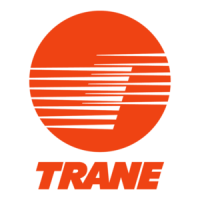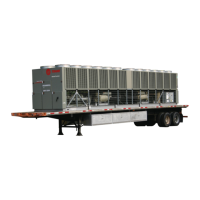RTAC-SVX002A-EN 59
Operating Principles
Evaporator
The evaporator is composed of a
liquid-vapor distributor and falling lm
evaporator.
A liquid-vapor refrigerant mixture enters
the distributor (state 4). The mixture
is distributed over the length of the
evaporator tubes (state 4b). Liquid is
evenly distributed over the length of
the evaporator tubes by the two-phase
distribution system. A portion of the
liquid boils as it falls by gravity from
tube to tube, wetting all the tubes of the
evaporator. To ensure that the tubes
at the bottom of the evaporator do not
experience “dry out,” a liquid pool is
maintained in the bottom few inches of
the bundle. Tubes located in the bottom
of the evaporator will evaporate the
liquid refrigerant by boiling (pool boiling).
Heat is transferred from the water or
glycol inside the tubes to the liquid
refrigerant as the lm of refrigerant
evaporates on the surface of the tube.
Thin lm heat transfer requires a smaller
temperature difference for a given
amount of heat transfer than nucleate
boiling, which is the heat transfer
process used in ooded evaporators.
Hence, efciency is enhanced by
the use of falling lm evaporation.
Additionally, the evaporator requires
less refrigerant than a comparable
ooded evaporator and the evaporator
boils the entire refrigerant supply at
constant pressure. Refrigerant vapor
exits the evaporator through the suction
line (state 1).
Oil System
Screw compressors require large
quantities of oil for lubricating and
sealing the rotors and lubricating
the bearings. This oil is mixed
with refrigerant at the discharge of
the compressor. To enhance the
performance of the heat exchanger
surfaces an oil separation system is
placed into the discharge line. The
oil separator is located between the
compressor and the condenser. It
separates oil using highly efcient
centrifugal force. Approximately 99.5%
of the oil is removed from the refrigerant
in the separator.
Oil that is removed from the refrigerant
falls by gravity into the oil sump. This
oil is directed back to the compressor
through the oil lines. Internal to the
compressor is a high efciency lter to
clean the oil before it is delivered to the
rotors and bearings. Once oil is injected
into the compressor rotors it mixes with
the refrigerant again and is delivered
back to the discharge line.

